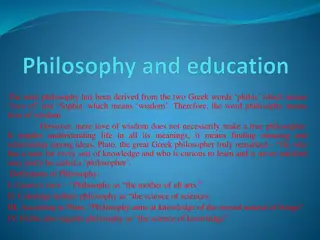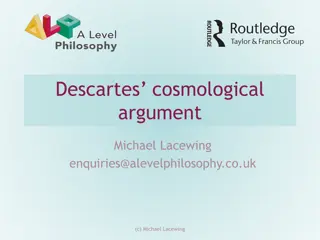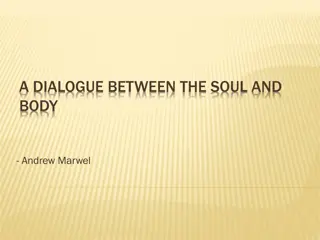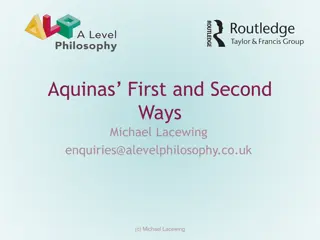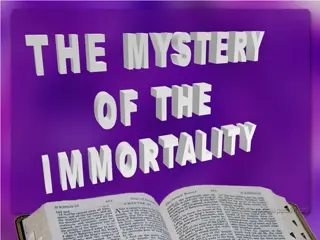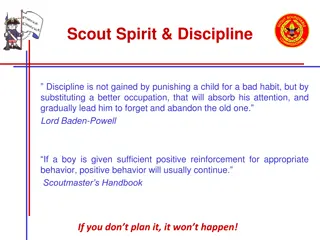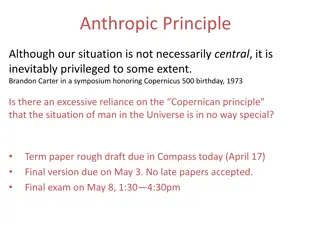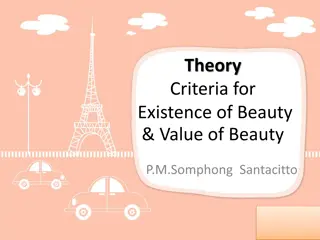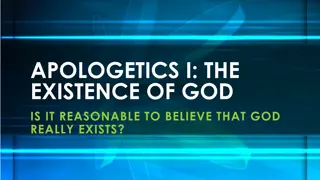Understanding the Body, Soul, and Spirit Paradigm in Human Existence
Exploring the concept of ternary anthropology introduced by French anthropologist Michel Fromaget, which views humans as composed of body, soul, and spirit. This paradigm, rooted in both Eastern and Western traditions, delves into the ontological value of the mind and the overall human experience. The discussion also touches on the historical roots of this paradigm in Ancient Philosophy and early Christianity, as well as its representation in modern anthropology.
Download Presentation

Please find below an Image/Link to download the presentation.
The content on the website is provided AS IS for your information and personal use only. It may not be sold, licensed, or shared on other websites without obtaining consent from the author. Download presentation by click this link. If you encounter any issues during the download, it is possible that the publisher has removed the file from their server.
E N D
Presentation Transcript
BODY, SOUL AND SPIRIT AND THE EXERCISE OF DEATH
Body, soul and spirit The french anthropologist Michel Fromaget coined the term ternary anthropology or spiritual anthropology . According to him, the ternary anthropology is a conception of human being common to the great traditions and religions of the East and the West It conceives human being as being the result of three fundamental elements: - The body (s ma) - the soul (psukh ) - the mind, or the intellect or the spirit (no s)
Body, soul and spirit It grants to the mind (no s) an ontological value i.e. a definitional value It formalises a conception of human being, an experience of the human condition. Modern anthropology only validates the two first dimensions i.e. the body and the soul
A few books written by Michel Fromaget (no english translations available)
The body, soul and spirit paradigm The term paradigm comes from the greek paradigma which means model or exemple It is a system of representation commonly accepted, formed of conceptual and theoretical presuppositions, that ensures a cohesive vision of the world suitable for a certain culture. A paradigm is a representation of reality amongst others
The body, soul and spirit paradigm It is not an objective image produced by an impartial gaze about a subject (the human being) that would be unmoved by the latter In other words an anthropological paradigm shapes human being himself in the direction designed by the model. In the next slides we will develop this three dimensions of human being.
General considerations Although the conception of the soul differs in each school of ancient, the three parts distinction in human being is an evidence for Ancient Philosophy but also Ancient Christianity. Plato, Aristotle, Marcus-Aurelius, Seneca, Saint-Augustine regularly refer to it. For example in his work The Republic, Plato does not merely distinguish the soul from the body, he also separates the soul (psukh ) from the mind (no s) and introduces a vision in three parts of human being.
General considerations Aristotle also distinguishes the soul from the mind in his treaty De anima (408 b 18 to 414 b). The part of the soul that is distinct from it, is called the active intellect. The active intellect is impassible, immobile, incorruptible, eternal, simple and primordial. Marcus-Aurelius also adopts a ternary conception of human being. He writes: There is three things of which you are composed: body, breath, and mind. Of these, the first two are your own in so far as it is your duty to take care of them; but only the third is your own in the full sense (Meditation 12.3).
General considerations Furthermore, Stoicism, Platonism and Neo-platonism, Ancient Christianity seem to share a common practice of disengagement of the no s (the third dimension of human being) from the perceptible world. This practice is often refered to in texts as being a separation from , a purification , a release , a collecting and bringing itself together etc. This is the exercise of death and separation of the body. But each school thereafter integrates this disengaged no s within its own philosophical system.
The body (som) The body, thanks to the five senses, opens on the physical world It is not only sensations, it also allows us to interact with the physical world A body may be seen as a sort of interface between ourselves and the surrounding reality. It is through our bodies that outside reality prints itself in ourselves and that we are able to memorise it.
The body (som) This is through the interaction of our bodies that we can express ourselves in the world and act upon it It is a sort of adaptive equipment that enables the soul to live in our world It allows to identify and localise the person who animates it. It even seems to be an essential function of the body.
The soul (psukh) The soul, in accordance with the latin etymology of the word, is anima . The greek equivalent is psukh The soul is nothing else than the psyche. We must be clear about this: the soul is this ensemble of functions or faculties that make a being alive, that animals are gifted of mobility, instincts, sensitivity, and that human beings can think, speak, dream and imagine. This meaning of soul is completely deprived of any idea of spirituality and immortality.
The soul (psukh) On the outside, the human soul presents itself as a system of faculties: cognitive (perception, intelligence), affective (emotions, feelings) and instictives (pulsions, needs). From within, the soul is the place of our interiority, the place where we live ourselves as being us , that is the conscience that we have of ourselves. The soul opens on other human beings souls and allows us to read other human beings souls i.e. to understand their emotions, to show empathy.
The soul (psukh) The soul is also action: my ideas and conceptions may act upon yours thanks to the language (spoken or not) If a body is alive, it is because it is animated by a soul The body and soul added form what we might call a biopsychic entity This biopsychic entity has adaptative and safeguard functions in the social and natural environment we are living in.
The soul (psukh) It fulfills this function not only for the individual but also simultaneously for the species. The soul is naturally egocentred. Its main concern is to ensure our safety and the fact that we are able to carry on. Human being often only use their cleverness to improve his comfort and the comfort of his biological species.
Psych ranime par le baiser de lamour (1793) Antonio Canova (1757-1822)
The mind (nos) The ternary anthropology understands human being and his life as participating to three different orders accomplished human being, or anthropos, simultaneously realises the three levels. of reality. The achieved or To glimpse , to sense or to see the no s, we must ourselves, however little it may be, having developed our no s. True constraint, isn't 'it ? That is why the no s cannot be defined, that is to be circumscribed with words, or even be watched face to face. Discursive intelligence can only, in a way, approach it in a peripheral way.
The mind (nos) For example, Plato says that the no s is the soul guide (Phaedo, 247 c) or the eye of the soul (Republic 533 e) Michel Fromaget nevertheless attempts a definition. The mind is a mysterious interiority that would only belong to human being and of which sages and saints say it is in him where he is rooted in God and where God gives himself to him
The mind (nos) The mind (no s) can open on something greater than human being that transcends him. Knowing ourselves means first of all recognize that we carry something divine within us, a particle of God . Cicero in his treaty writes: For he who know himself will think first that he has something divine, and that his own natural abilities within himself like a sort of consecrated image. An he will always do and feel something worthy of such great gift of the gods (De Legibus, book I, 59)
The mind (nos) Epictetus very often reminds to his students that they carry a fragment of God within themselves. He says: You, on the other hand, are a creature placed in charge, and a particle of God himself; there is a bit of God within you (Discourses, II, 8.11). In Stoicism, there is a total equivalence between the following terms: no s, dianoia, hegemonikon and daim n (Pierre Hadot, the inner citadel). The notion of daim n refers to some sort of divine principle.
The experience of the nos According to Michel Fromaget, since the dawn of time, in the East and the West, men and women experimented that the human being, far from being condemned to live in a two dimensional world, is able to explore another depth of himself. He gathered testimonies of persons all around the world who experienced it. These testimonies are of course very subjective but it seems that we can nethertheless list five common characteristics:
The experience of the nos feeling of joy. This is a joy of liberation, a joy of birth feeling of peace, serenity and certainty that comes from the certainty of being, that is born on the encounter with the truth that frees us from ourselves. removal of selfhood, taking with it all its conceptions, its fears. feeling of immortality dissipation of death feeling of proximity
The experience of the nos The subject that make the experience of the no s a the clear feeling that it opens him/her on the totality of his/her being. He/she is aware that this experiment transforms him/her or begins to transforms him/her in direction of this totality. It is felt and received as being fundamental both for the individual and the species. This experienced is felt and described as being a second birth and can be compared to the metamorphosis of the caterpillar in butterfly. Another way of expressing this experience of the no s is the anamorphic image.
Anamorphic image An anamorphic image is a reversible deformation of an image thank to an optical system (e.g. a curved mirror) or a mathematical process
The exercise of death Plato explains that the distinction between firstly the soul and the body and secondly between the soul and the mind is not only intellectual. It really must be performed in our lives thanks to an exercise of detachement of the body, of purification. This exercise is similar to death, and philosophy a learning of death.
The exercise of death Then, said Socrates, if this is true, my friend, I have great hopes that when I reach the place to which I am going, I shall there, if anywhere, attain fully to that which has been my chief object in my past life, so that the journey which is now imposed upon me is begun with good hope; and the like hope exists for every man who thinks that his mind has been purified and made ready. Certainly, said Simmias. And does not the purification consist in this which has been mentioned long ago in our discourse, in separating, so far as possible, the soul from the body and teaching the soul the habit of collecting and bringing itself together from all parts of the body, and living, so far as it can, both now and hereafter, alone by itself, freed from the body as from fetters? Certainly, said he. Well, then, this is what we call death, is it not, a release and separation from the body? Exactly so, said he. "But, as we hold, the true philosophers and they alone are always most eager to release the soul, and just this the release and separation of the soul from the body is their study, is it not? . Obviously. Then, as I said in the beginning, it would be absurd if a man who had been all his life fitting himself to live as nearly in a state of death as he could, should then be disturbed when death came to him. Would it not be absurd? (Plato, Phaedo 67 c).
The exercise of death Stoics also seem to practice a similar exercise of detachment from the body, a purification of the no s that is described by Marcus-Aurelius
The exercise of death There are three things of which you are composed of: body, breath and mind. Of these, the first two are your own in so far as it is your duty to take care of them; but only the third is your own in the full sense. So if you will put away from yourself that is to say from your mind all that others do or say, and all that you yourself have done or said, and all that troubles you with regard to the future, and all that belonging to the body which envelops you and the breath conjoined with it attached to you independently of your will, and all of the vortex whirling around outside you sweeps in its wake, so that the power of your mind, thus delivered from the bonds of fate, you may live a pure and unfettered life alone with itself, doing what is just, desiring what come to pass, and saying what is true. If I say, you will put away from your governing faculty all that accretes to it from the affections of the body, and all that lies in the future or in time gone by, and make yourself, in Empedocles word, a well rounded sphere rejoicing in the solitude around it , and strive to live only the life that is your own, that is to say your present life, then you will be able to pass at least the time that is left to you until you die in calm and kindliness, and as one who is at peace with the guardian-spirit that dwells within it (Meditation 12.3)
The exercise of death Indeed, an hegemonikon that completely and utterly identifies itself to external things adopts an egocentric vision of the world. It then becomes what Marcus-Aurelius calls a stranger in the universe (Meditation 4.29) who reacts excessively to events that present themselves to him/her instead maintaining himself/herself equal distance from the contingent realities. The goal is to avoid that the no s gets attached to and alienates to external things, putting away from itself the multiples sensory and non sensory impressions in order not to be carried by them. In doing so the no s collects and brings itself together to make itself, in Empedocles words, a well rounded sphere rejoicing in the solitude around it .
The exercise of death This practice of death has been later adopted by Eastern orthodox church and became the Hesychastic introduced, such as the invocation of the Name, but the foundations remain the same. Saint John Climacus a 7th-century christian monk, describes a practice of circumscribing the incorporeal (no s) within the body instead of letting it scatter outside. Saint Gregory Palamas [1296-1359] explains that it consists for a person in returning in himself, by certain processes, his spirit. The one who tries to get back his spirit in himself tries to push it not to the movement in a straight line (towards the outside), but in the circular and infallible movement (of return on himself). tradition. Some modifications were
The exercise of death Those who have just begun this fight see constantly their spirit (no s) running away: hardly collected; it is thus necessary to them to return it to them so constantly. In their inexperience, they do not realize that nothing to the world is more difficult to contemplate and more mobile than the spirit. That is why some people recommend them to check comings and goings of the breath and to retain it a little, to retain also the spirit by staying up the breath until by means of God they progressed until they forbade their spirit all which surrounds it and cleansed it, and until they can return it really to a unified meditation. And we can notice that it is a spontaneous effect of the attention of the spirit there, because comings and goings of the breath becomes peaceful during any intense meditation, especially to those who are, of body and spirit, in the rest (Saint Gregory Palamas. D fense Des Saints H sychastes by J. Meyendorff ).
The exercise of death This extract enlights the fact that the exercise of death and of separation of the body is a meditative practice using a respiratory technique that is probably inherited from the Greek philosophers. Gregory Palamas notes that the spirit is very mobile . Hence the Hesychast tradition precises that the spirit is aeikinetos kai polukinetos which means always and extremely agitated . Hence it has to be quieted. In this respect, it is also interesting to read the Buddhist masters. Although they reported the mindfulness experience with very different words from the ancient philosophers ones, the laws of the human psyche are universal.
The union with the divine Marcus-Aurelius Dig within; for within you lies the fountain of good, and it can always be gushing forth if only you always dig (Meditation 7.59) In the no s is registered the fountain of good that is an attraction for the virtue capable of triumphing over all the requests of the external things But in fact, these divine energies are still in him only in the state of germs or seeds of virtue that will require an education a paideia- to bloom in a spontaneous orientation of all the movements of his psyche towards God (Nature) doing what is just, desiring what come to pass, and saying what is true.
The union with the divine This state of harmonization with the divine seems to be the authentic human nature. If this state is not achieved, the man will live in a kind of waking dream (tuphos, literally mist or fog ), of an unreal world where the good and evil, the truth and the forgery, are only estimated according to its own affective tendencies. The practice of the exercise of death enables the human being to get out of the waking dream, to be a-leth , to be awakened or egregoros (Heraclitus, fragment n 89).
The union with the divine The sphere of the soul is faithful to its form when it neither reaches out towards anything outside itself nor contracts inwards, and when it is neither dispersed abroad nor dies down, but shines forth with a steady light by which it beholds the truth of all things and the truth within itself (Marcus- Aurelius, Meditation 11.12) .
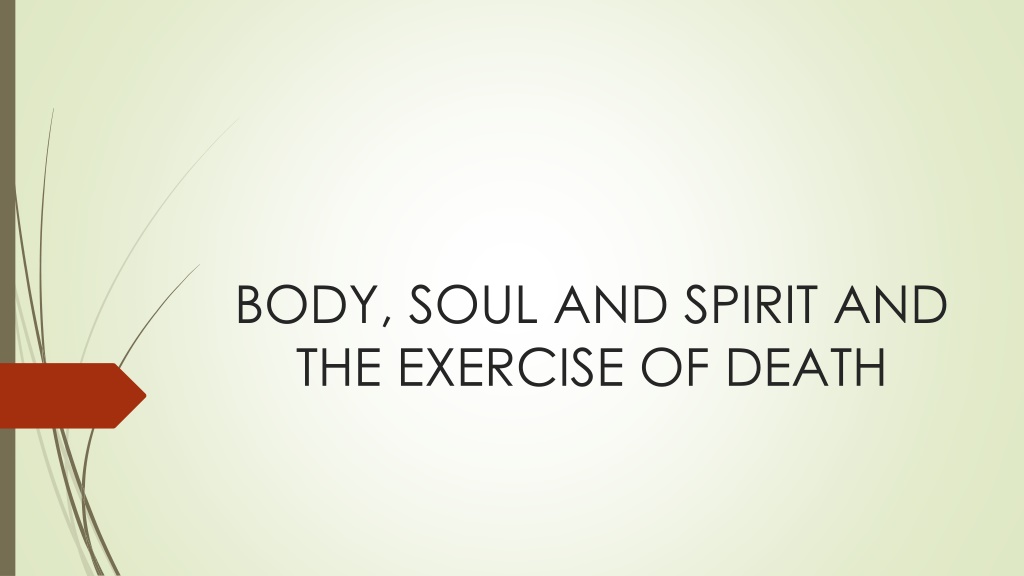


![[PDF⚡READ❤ONLINE] Black Hole Astrophysics: The Engine Paradigm (Springer Praxis](/thumb/21503/pdf-read-online-black-hole-astrophysics-the-engine-paradigm-springer-praxis.jpg)


